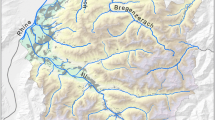Abstract
Over decades, the planning of flood management was based on a safety-oriented approach. A design flood was estimated by probabilistic means to specify the limit up to which a flood should be controlled completely by technical measures. A case of failure was expected only in such cases where the design flood is overtopped. As design floods were specified by very small probabilities, the risk of a flood beyond the design flood was seen as negligible. Devastating flood events all over Europe raised the public awareness of remaining flood risks in the last two decades. Risk management became a political task in the EU. According to the European Flood Directive geographical areas, which could be flooded “with a low probability or under extreme event scenarios”, have to be specified. The combination of “low probability” and “extreme event scenarios” demonstrates the problem of modern flood management. The existing probabilistic tools are not sufficient to specify the risks of failures, which result from critical combinations of multiple characteristics of hydrological loads. Scenarios are one option to specify them, but their probabilities stay unknown. Multivariate statistics could offer a way to fill this gap, but some problems of their practical application are still unresolved.





Similar content being viewed by others
References
Apel H, Thieken AH, Merz B, Blöschl G (2004) Flood risk assessment and associated uncertainty. Nat Hazards Earth Syst Sci 4(2):295–308. doi:10.5194/nhess-4-295-2004
Apel H, Merz B, Thieken AH (2008) Quantification of uncertainties in flood risk assessments. Intl. J. River Basin Management (6)
Apel H, Merz B, Thieken A (2009) Influence of dike breaches on flood frequency estimation. Comput Geosci 35(5):907–923. doi:10.1016/j.cageo.2007.11.003
Bachmann D, Huber NP, Johann G, Schüttrumpf H (2013) Fragility curves in operational dike reliability assessment. Georisk: Assess Manag Risk Eng Syst Geohazards 7(1):49–60. doi:10.1080/17499518.2013.767664
Charalambous J, Rahman A, Carroll D (2013) Application of Monte Carlo simulation technique to design flood estimation. A case study for north Johnstone River in Queensland, Australia. Water Resour Manag 27(11):S. 4099–S. 4111. doi:10.1007/s11269-013-0398-9
Costa JE (1978) The dilemma of flood control in the United States. Environ Manag 2(4):313–322. doi:10.1007/BF01866671
Cunnane C (1987) Review of Statistical Models for Flood Frequency Estimation. In: Singh V (ed) Hydrologic Frequency Modeling. Springer Netherlands, pp 49–95
Cunnane C (2009) Factors affecting choice of distribution for flood series. Hydrol Sci J 30(1):25–36. doi:10.1080/02626668509490969
De Michele C, Salvadori G, Canossi M, Petaccia A, Rosso R (2005) Bivariate statistical approach to check adequacy of dam spillway. J Hydrol Eng 10(1):50–57. doi:10.1061/(ASCE)1084-0699(2005)10:1(50)
DIN (2004) Deutsches Institut für Normung e. V Stauanlagen-Teil 11: Talsperren (Dam plants - Part 11: Dams) 93.160(19700–11:2004–07)
European Commission (2007) Directive 2007/60/EC of the European Parliament and of the Council of 23 October 2007 on the assessment and management of flood risks. http://ec.europa.eu/environment/water/flood_risk/index.htm. Accessed 27 September 2016
Favre A, El Adlouni S, Perreault L, Thiémonge N, Bobée B (2004) Multivariate hydrological frequency analysis using copulas. Water Resources Research 40(1). doi:10.1029/2003WR002456
Fischer S, Schumann A (2015) Robust flood statistics: comparison of peak over threshold approaches based on monthly maxima and TL-moments. Hydrol Sci J 61(3):457–470. doi:10.1080/02626667.2015.1054391
GDV (2014) Das Juni-Hochwasser 2013 – Ein Jahr danach. http://www.gdv.de/2014/05/die-meisten-schaeden-entstanden-weitab-der-grossen-fluesse/
Gräler B, van den Berg MJ, Vandenberghe S, Petroselli A, Grimaldi S, de Baets B, Verhoest NEC (2013) Multivariate return periods in hydrology: a critical and practical review focusing on synthetic design hydrograph estimation. Hydrol Earth Syst Sci 17(4):1281–1296. doi:10.5194/hess-17-1281-2013
Hall JW, Dawson RJ, Sayers PB, Rosu C, Chatterton JB, Deakin R (2003a) A methodology for national-scale flood risk assessment. Proc Institution Civ Eng - Water Marit Eng 156(3):235–247. doi:10.1680/wame.2003.156.3.235
Hall JW, Meadowcroft IC, Sayers PB, Bramley ME (2003b) Integrated flood risk Management in England and Wales. Nat Hazards Rev 4(3):126–135. doi:10.1061/(ASCE)1527-6988(2003)4:3(126)
Hall J, Arheimer B, Borga M, Brázdil R, Claps P, Kiss A, Kjeldsen TR, Kriaučiūnienė J, Kundzewicz ZW, Lang M, Llasat MC, Macdonald N, McIntyre N, Mediero L, Merz B, Merz R, Molnar P, Montanari A, Neuhold C, Parajka J, Perdigão RAP, Plavcová L, Rogger M, Salinas JL, Sauquet E, Schär C, Szolgay J, Viglione A, Blöschl G (2014) Understanding flood regime changes in Europe: a state-of-the-art assessment. Hydrol Earth Syst Sci 18(7):2735–2772. doi:10.5194/hess-18-2735-2014
Hundecha Y, Pahlow M, Schumann A (2009) Modeling of daily precipitation at multiple locations using a mixture of distribution to characterize the extremes. Water Resour Res 45(W12412):1–15. doi:10.1029/2008WR007453
Kellens W, Vanneuville W, Verfaillie E, Meire E, Deckers P, de Maeyer P (2013) Flood risk Management in Flanders. Past developments and future challenges. Water Resour Manag 27(10):S. 3585–S. 3606. doi:10.1007/s11269-013-0366-4
Klein B, Pahlow M, Hundecha Y, Schumann A (2010) Probability analysis of hydrological loads for the Design of Flood Control Systems Using Copulas. J Hydrol Eng 15(5):360–369
Klein B, Schumann AH, Pahlow M (2011) Copulas – new risk assessment methodology for dam safety. In: Schumann AH (ed) Flood risk assessment and management: how to specify hydrological loads. Their Consequences and Uncertainties. Springer Science+Business Media B.V, Dordrecht, pp 149–185
Lindström G, Johansson B, Persson M, Gardelin M, Bergström S (1997) Development and test of the distributed HBV-96 hydrological model. J Hydrol 201:272–288
Merz B, Hall J, Disse M, Schumann A (2010) Fluvial flood risk management in a changing world. Nat Hazards Earth Syst Sci 10(3):509–527
Milly PCD, Betancourt J, Falkenmark M, Hirsch RM, Kundzewicz ZW, Lettenmaier DP, Stouffer RJ (2008) CLIMATE CHANGE: stationarity is dead: whither water management? Science 319(5863):573–574. doi:10.1126/science.1151915
Munich Re Loss events worldwide 1980 - 2015. (2016) https://www.munichre.com/site/touch-naturalhazards/get/documents_E-1125431578/mr/assetpool.shared/Documents/5_Touch/_NatCatService/Focus_analyses/Loss_events_worldwide_1980-2015.pdf Accessed 26 October 2016
Nelsen RB (2005) Dependence Modeling with Archimedean Copulas. Proceedings of the Second Brazilian Conference on Statistical Modeling in Insurance and Finance, Institute of Mathematics and Statistics, University of Sao Paulo (2005), pp 45–54
Nelsen RB (2006) An Introduction to Copulas, 2. ed. 2006. Springer series in statistics. Springer New York, New York
Salvadori G, De Michele C (2004) Frequency analysis via copulas: theoretical aspects and applications to hydrological events. Water Resour Res 40(12). doi:10.1029/2004WR003133
Salvadori G, De Michele C (2007) On the use of copulas in hydrology: theory and practice. J Hydrol Eng 12(4):369–380. doi:10.1061/(ASCE)1084-0699(2007)12:4(369)
Salvadori G, De Michele C, Durante F (2011) On the return period and design in a multivariate framework. Hydrol Earth Syst Sci 15(11):3293–3305. doi:10.5194/hess-15-3293-2011
Salvadori G, Durante F, De Michele C (2013) Multivariate return period calculation via survival functions. Water Resour Res 49(4):2308–2311. doi:10.1002/wrcr.20204
Salvadori G, Durante F, De Michele C, Bernardi M, Petrella L (2016) A multivariate copula-based framework for dealing with hazard scenarios and failure probabilities. Water Resour Res 52(5):3701–3721. doi:10.1002/2015WR017225
Sayers PB, Hall JW, Meadowcroft IC (2002) Towards risk based flood hazard management in the UK. Proceedings of the ICE, Civil Engineering 150(5):36–42. doi:10.1680/cien.150.5.36.38631
Schulte M, Schumann A (2015) Downstream-directed performance assessment of reservoirs in multi-tributary catchments by application of multivariate statistics. WRM 29(2):419–430. doi:10.1007/s11269-014-0815-8
Schumann A, Nijssen D (2011) Application of scenarios and multi-criteria decision making tools in flood polder planning. In: Schumann AH (ed) Flood risk assessment and management: how to specify hydrological loads, Their Consequences and Uncertainties. Springer Science+Business Media B.V, Dordrecht, pp 249–275
Shiau J, Wang H, Tsai C (2006) Bivariate frequency analysis of floods using copulas. Journal of the American Water Resources Association 42(6):1549–1564. doi:10.1111/j.1752-1688.2006.tb06020.x
Serinaldi F, Kilsby CG (2015) Stationarity is undead: uncertainty dominates the distribution of extremes. Adv Water Resour 77:17–36. doi:10.1016/j.advwatres.2014.12.013
Sieber H-U (2000) Hazard and risk assessment considerations in German standards for dams – present situation and suggestions. In: ICOLD (ed) XX. ICOLD Congress: Q.76; R.43
Simm J, Gouldby B, Sayers P, Flikweert J, Wersching S, Bramley M (2009) Representing fragility of flood and coastal defences: getting into the detail. In: Samuels P (ed) Flood risk management: research and practice; proceedings of the European conference on flood risk management research into practice (FLOODrisk 2008), Oxford, UK, 30 September - 2 October 2008. CRC Press, Boca Raton
Sklar A (1959) Fonctions de rèpartition à n dimensions et leurs marges. Publ Inst Stat Univ Paris 8:229–231
Srdjevic B, Medeiros YDP (2008) Fuzzy AHP assessment of water management plans. WRM 22(7):877–894. doi:10.1007/s11269-007-9197-5
Viglione A, Merz B, Viet Dung N, Parajka J, Nester T, Bloschl G (2016) Attribution of regional flood changes based on scaling fingerprints. Water Resour Res 52(7):5322–5340. doi:10.1002/2016WR019036
Volpi E, Fiori A, Grimaldi S, Lombardo F, Koutsoyiannis D (2015) One hundred years of return period: strengths and limitations. Water Resour Res 51(10):8570–8585. doi:10.1002/2015WR017820
Woods R, Sivapalan M (1999) A synthesis of space-time variability in storm response: rainfall, runoff generation, and routing. Water Resour Res 35(8):2469–2485
Yevjevich V (1991) Tendencies in hydrology research and its applications for 21st century. Water Resour Manag 5(1):1–23. doi:10.1007/BF00422036
Zhang L, Singh V P (2006) Bivariate flood frequency analysis using the copula method. Journal of Hydrologic Engineering 11(2):150–164. doi:10.1061/(ASCE)1084-0699(2006)11:2(150)
Author information
Authors and Affiliations
Corresponding author
Rights and permissions
About this article
Cite this article
Schumann, A. Flood Safety versus Remaining Risks - Options and Limitations of Probabilistic Concepts in Flood Management. Water Resour Manage 31, 3131–3145 (2017). https://doi.org/10.1007/s11269-017-1700-z
Received:
Accepted:
Published:
Issue Date:
DOI: https://doi.org/10.1007/s11269-017-1700-z




